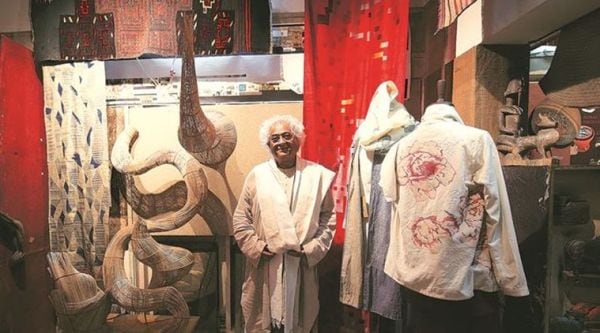Melting Hierarchies
Rajeev Sethi on what Village India can do for the world, the privilege of the hand in bespoke and wanting to paint more

(Above) Rajeev Sethi; the exhibits tell stories of Sethi’s Asian Heritage Foundation’s interventions, from ikat tunics to pottery painted in Mandala patterns (Express Photo by Amit Mehra)
The problem sometimes with new media is that they decontextualise art to a point where in this urge to be international the sap dries up. Satyajit Ray never had to worry about being international. We are obsessed with what’s my style, my addition to the world,” says arts impresario Rajeev Sethi. Coming from the man who has been instrumental in the preservation and promotion of Indian heritage and art the world over, these thoughts come as a reflection and an exhortation.
Seated in the library of his organisation, Asian Heritage Foundation’s South Extension home, he pauses as his voice soon becomes inaudible before the louder choir of folk artistes singing Bandhan Se Mukt Hai Dishaye — an anthem composed for the foundation to impress on the needs of folk artists and craftspeople more than two decades ago — in the central atrium. He has spent a lifetime to make their voices heard. The endeavour is also the focus of the ongoing 19-day showcase, where Sethi is inviting a “public stocktaking” of Jiyo, a design-led empowerment programme for skilled communities across India for better livelihood. He is also bidding farewell to the building he has occupied for 20 years. This is where he held meetings with international designers such as Calvin Klein and the Louis Vuitton team, and where he conceived numerous projects that made traditional skills mainstream, blurring the distinction between craft and art.
Even as the audience — including chief guest Dharmendra Pradhan, Minister of Petroleum & Natural Gas and Skill Development & Entrepreneurship, photographer Raghu Rai, fashion designer Ritu Kumar and artist Manisha Parekh — mingled with members of the several cooperatives that Sethi has established across India at the opening of the festival on October 2, the curator implored how a lot still remains to be achieved. After telling the story of India through art and envisioning the much-acclaimed art corridor at Mumbai’s T2 terminal, scenographer Sethi will be working on another airport project in India, but he hopes to “retire” soon. “I am handing over the batton to the young. I want to paint. I want to write more,” says Sethi, who famously trained under painter and printmaker Stanley William Hayter at his studio, Atelier 17, Paris. Mentored by Ray and Charles Eames, Pupul Jayakar and Kamaladevi Chattopadhyay, he awaits new beginnings but engagements with the grassroots are perhaps inevitable.
More than an introspection, the ongoing showcase is an introduction to the backstories and faces behind the traditional wares that Sethi’s foundation has been designing and promoting, from hand-painted kalamkari textiles to pickles from Guntur and lamps inspired by leather puppets, among others. “It is important to explore what Village India can make for themselves, the urban young and the world markets,” he says, guiding us through several installations that feature 200 new prototypes spread across the building. He quickly moves between the various exhibits — from asymmetrical pottery painted in Mandala patterns to ikat tunics, trunks painted by Gond artists to bamboo installations by fish trappers. Admiring a suzani hand-embroidered stole he emphasises on the charm of asymmetry, no possibility of replication. “What the hand has in place is bespoke. It drops hierarchies between fine art and craft, what is rural and urban, margi and desi. It is beyond the divide of western and eastern,” he notes.
In the coming days, the house is open for discussions and debates. If in one corner Maroof Attir is sharing notes on Indian attars, in another, block printers from Bagh are demonstrating the traditional art.
The showcase is at C-52, South Extension II till October 20






















No hay comentarios:
Publicar un comentario